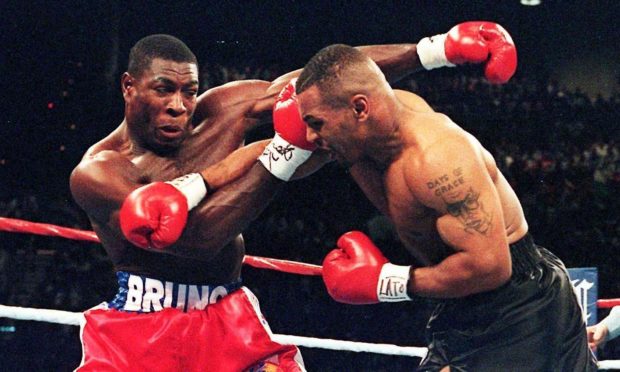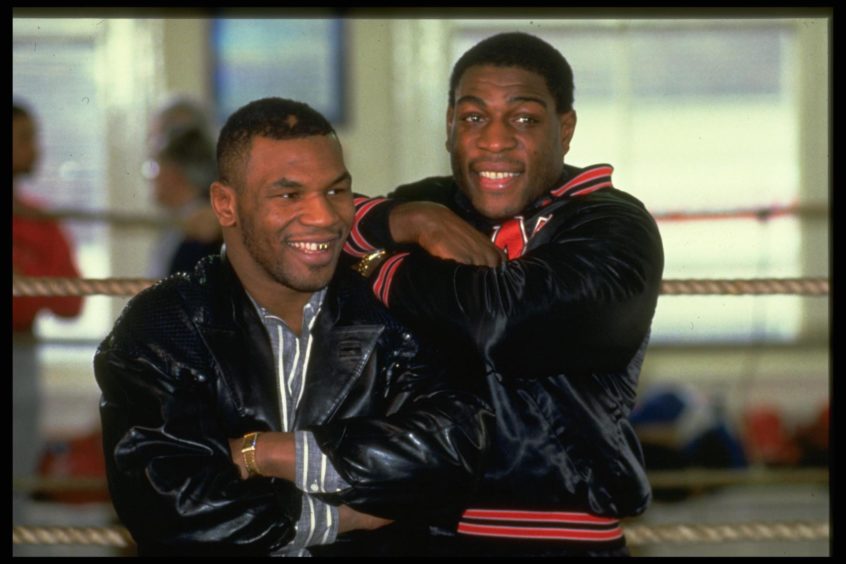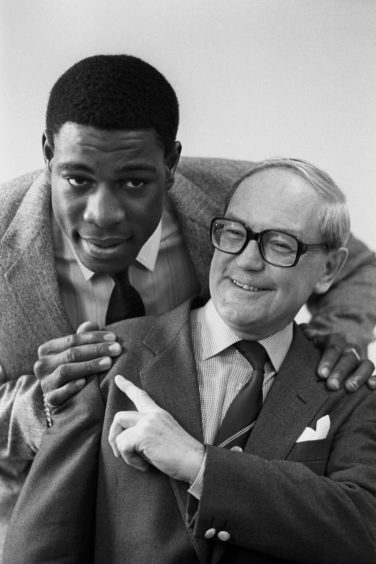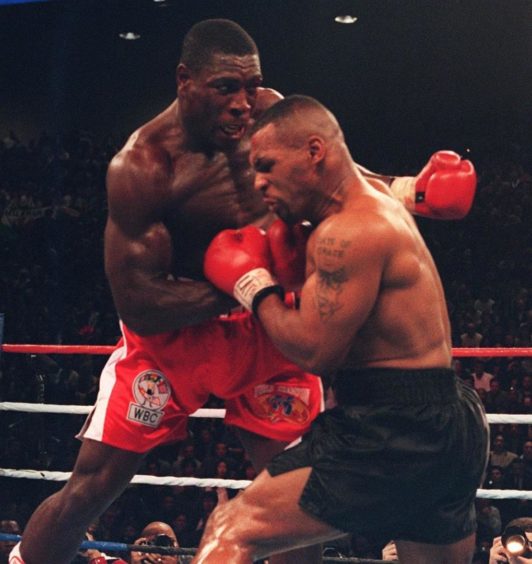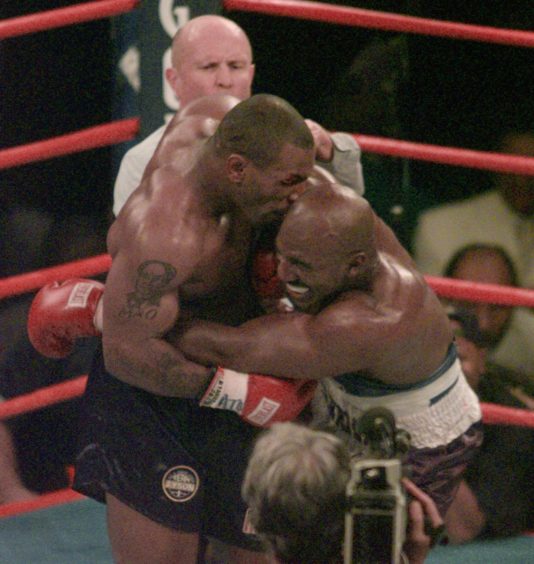There has always been a tragi-comic element to boxing; the contrast between the Damon Runyon language of rope-a-dopes and palookas on the road to Nowhereville and the sad sight of punch-drunk fighters slurring their words.
There was even the time when a BBC continuity announcer seemed to have sustained one blow too many to his head while telling his audience: “And your carpenter will be Harry Commentator”, in the prelude to a major 1970s bout.
Yet few figures in the fistic business have provoked such strong emotions as Frank Bruno and Mike Tyson, whose epic clashes of style and temperament have been put under the microscope in a visceral, vivid new Sky documentary which reminds you that, despite the plethora of lurid headlines which surrounded both men, in and out of the ring, they were the real deal when it came to serving up heavyweight action.
Bruno, who turns 60 later this year, might have suffered mental health issues and been diagnosed with bipolar disorder when he left the sport and departed the pantomime circuit, but too many people forget about the formidable strength he possessed at the height of his powers while becoming WBC heavyweight champion after beating Oliver McCall at a packed Wembley Stadium in 1995.
And, even if Tyson subsequently knocked him to the canvas in Las Vegas the following year, abruptly switching out the lights on his boxing career, the big, genial English fighter has never lost the cult audience he amassed throughout his successes.
Let your guard slip and, boom, you are gone
The bold Bruno was renowned for his exceptional punching power, with a 95% knockout-to-win ratio in 38 of 40 fights. But, amidst all these victories, his genial behaviour and jocular demeanour masked his underlying apprehension at the thought of how quickly the rug could be pulled from under his feet.
In the end, as with most careers, that’s exactly what happened and his description of how it unravelled showed that he was smarter than your average Joe.
He said: “Being heavyweight champion of the world taught me a lot, but it made me realise one thing above everything else.
“And that is that everything you fight for, everything you dream of, everything you build up, can be snatched away in the blink of an eye. Let your guard slip even once, then boom, from nowhere, you are down and you are out.”
He and Tyson were both close to the late Carpenter. Indeed, Bruno and Harry became a notable double act, while “Iron” Mike, in the days before he was embroiled in ear-biting scandals and receiving a six-year jail sentence for the rape of Desiree Washington (he spent three years behind bars) once took part in a documentary with the beetle-browed TV sports presenter about the early greats in the heavyweight realm.
Bruno’s north-east links with football and films
One might not envisage that the Wandsworth-born Bruno would have any links to the north-east of Scotland.
But he has, both in football and the film world.
When Aberdeen reached the final of the Scottish League Cup and beat Inverness Caley in 2014, the Dons enjoyed the backing of big Frank, who had watched and marvelled at the exploits of the Pittodrie club under Alex Ferguson in the early 1980s.
His own professional career commenced in 1982, just a few months before that famous night in Gothenburg when Ferguson’s team won the European Cup Winners’ Cup by overcoming Real Madrid – and it left an indelible impression on the boxer.
All of 32 years later, on the eve of the Cup final for Derek McInnes’ side, he revealed: “If my old mate Terry Butcher had still been with Inverness, it might have been different.
“But, while in England, West Ham are my team, in Scotland I shout for the Dons.”
Bruno also made a cameo appearance in one of the early films produced by Peterhead-born director Jon S Baird, who was recently shooting scenes for his new work Tetris at various locations in Aberdeen (which is doubling for Soviet Russia in the movie).
Cass was the true story of a Jamaican orphan who was adopted by an elderly couple in an all-white area of London and endured a childhood blighted by racial abuse which he only escaped when he joined forces with fellow West Ham supporters as an adult.
All of his pent-up rage was the catalyst for him becoming part of a group of football casuals, and after a time in prison, Cass (Pennant) was forced to choose between revenge and his loved ones.
It was a scenario which mirrored aspects of Bruno’s own often harrowing life, especially when he was sectioned at Basildon Hospital in 2012.
Frank’s biggest battle has been outside the ring
He later revealed in a strikingly candid autobiography Let Me Be Frank: “My room was no bigger than a cell. I put my suitcase on top of an old chest of drawers and sank on to the narrow bed. Then I looked up and realised there were no windows.
“I was a former champion of the world, for God’s sake. But now, I felt like an animal in a zoo, and it was as if I had been completely stripped of my dignity.
“Even when I began to fight against being given so many drugs, the doctors insisted that I had to keep on taking the medication. I told them, time and time again, that they were making me feel worse…like a zombie.”
Despite the memory of these privations, he has rallied from the pits of depression, but realises that he will have to deal with these issues for the rest of his existence. He has good days and bad days. But the latter can arrive in an instant: “The illness is like a force of nature. A haymaker of a right hook that rocks me from side to side.”
Tyson’s story is like a Hollywood parable
Mike Tyson’s story embodies so many different facets that it is difficult to pigeonhole him. He might be dismissed as a criminal, a sex-offender, a thug and a blot on the whole boxing business by many people – and there were plenty of protests when I watched him demolish the hapless Lou Savarese at Hampden Park in 2000 – but the American has also been duped, treated like a patsy and shown himself to be an intelligent and even sensitive man when he isn’t impersonating a raging bull.
Aberdeen journalist Vic Robbie was among those who witnessed him in his latter incarnation in 1987 and still shudders at the thought of it.
He recalled: “The undisputed world champion Mike Tyson was defending his titles in Atlantic City against his countryman Tyrell Biggs, who had made derogatory remarks about the champion.
“And Tyson ruthlessly dismantled his opponent who eventually succumbed in the seventh round. Iron Mike admitted that he wanted him to pay for his loose talk and afterwards said: ‘Every time I hit him, he screamed like a woman’.
“That was understandable, because I was frightened just talking to him.”
But Tyson thought a lot more of Bruno
A lot of the trash talk from the 1980s and 1990s boxing scene leaves a horribly sour taste in the mouth. None of it is suitable for family entertainment in the 21st century.
Yet, despite the bruising scraps which Tyson and Bruno had in 1989 and 1996, there’s a lot of mutual admiration and, whisper it, affection between these old combatants.
Tyson regards his former opponent as “a sweet man, a really docile guy who had a big punch when he was fired up”.
And when they met again recently to film the new documentary, his embrace of his British comrade was genuinely touching.
Any bad blood which might have existed has clearly vanished during the intervening period when the duo have both suffered very personal misfortunes and bounced back to the stage where it seems they are in a good pace, both mentally and physically.
As for Bruno, the ordeals and struggle with even pronouncing his illness – “I sometimes say I have bi-polo and people laugh” – have been exorcised by his new determination to accentuate the positives and become a mental health campaigner.
He still waxes lyrical about his old adversary. Talking about Tyson, he said: “Mike had the fastest hands of them all. He was a good all-rounder and brilliant attacker.
“He was able to multi-task by reading my moves and punch at the same time as well as dodge. His punches came very quick given his size. He was definitely an animal in the ring, he knew what he wanted and he went for it.”
That, however, was the past. The hatchet has been buried and there has been a tender reunion between them.
It is another reminder of how boxing evokes so many emotions.
EYEWITNESS: Concorde, marathons and meeting Iron Mike all featured in Vic Robbie’s thrilling career
